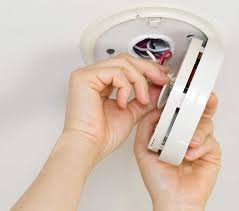Installing Smoke Alarms for the Hard-of-Hearing Community
 |
| “I Love You,” a Combination of the Letters I, L and Y |
It was sheer coincidence that brought Red
Cross Home Fire Campaign volunteer Derek Yeager to the home of a man named
Michael in Sweet Home, Oregon on the afternoon of June 16, 2017. Yeager, a resident
of Albany who works through the Salem office, was installing smoke detectors
that day along with Amanda Bender, a Home Fire Campaign team member working
through Americorps. The pair had already installed dozens of smoke detectors
that day, but the Sweet Home installation would be different.
Cross Home Fire Campaign volunteer Derek Yeager to the home of a man named
Michael in Sweet Home, Oregon on the afternoon of June 16, 2017. Yeager, a resident
of Albany who works through the Salem office, was installing smoke detectors
that day along with Amanda Bender, a Home Fire Campaign team member working
through Americorps. The pair had already installed dozens of smoke detectors
that day, but the Sweet Home installation would be different.
The Sweet Home installation was that of
a deaf or hard-of-hearing (DHH) Bed Shaker Alarm system. As with sound-based
alarms, DHH alarms are available through the Home Fire Campaign, and Michael had
ordered an installation to protect himself. When Yeager and Bender arrived at Michael’s
residence, Yeager noticed that Michael was standoffish and seemed apprehensive
about communicating with them. “For a
person who is deaf or hard of hearing,” Yeager explained, “living in a hearing
world can sometimes feel alienating.”
a deaf or hard-of-hearing (DHH) Bed Shaker Alarm system. As with sound-based
alarms, DHH alarms are available through the Home Fire Campaign, and Michael had
ordered an installation to protect himself. When Yeager and Bender arrived at Michael’s
residence, Yeager noticed that Michael was standoffish and seemed apprehensive
about communicating with them. “For a
person who is deaf or hard of hearing,” Yeager explained, “living in a hearing
world can sometimes feel alienating.”
That feeling of
alienation is something Yeager understands well: Although Yeager was born with the ability to
hear, he lost his hearing soon afterward in infancy. Fortunately, Yeager’s hearing was restored by
surgery that removed scar tissue.
Nevertheless, “American Sign Language (ASL) was my first language,” he explained. Yeager was able to sign to Michael, putting
him at ease. Yeager explained critical
information to him about the use of the DHH alarm to ensure the system’s
effectiveness.
alienation is something Yeager understands well: Although Yeager was born with the ability to
hear, he lost his hearing soon afterward in infancy. Fortunately, Yeager’s hearing was restored by
surgery that removed scar tissue.
Nevertheless, “American Sign Language (ASL) was my first language,” he explained. Yeager was able to sign to Michael, putting
him at ease. Yeager explained critical
information to him about the use of the DHH alarm to ensure the system’s
effectiveness.
The Bed Shaker Alarm system does not
operate on its own, but rather works in conjunction with traditional sound-based
smoke detectors. While there are several
DHH alarm systems on the market, each with different
features, the Bed Shaker DHH system is positioned under a pillow or a mattress. It produces a low-frequency sound or visual
alert and vibrates three to four times to wake a sleeping person when it
detects the sound alert of a smoke detector. An added feature of the Bed Shaker
system is that it can also be used as an alarm clock, which conditions its
users to being awoken by the vibration.
operate on its own, but rather works in conjunction with traditional sound-based
smoke detectors. While there are several
DHH alarm systems on the market, each with different
features, the Bed Shaker DHH system is positioned under a pillow or a mattress. It produces a low-frequency sound or visual
alert and vibrates three to four times to wake a sleeping person when it
detects the sound alert of a smoke detector. An added feature of the Bed Shaker
system is that it can also be used as an alarm clock, which conditions its
users to being awoken by the vibration.
 |
| Installing an Alarm |
By signing to Michael,
Yeager explained the DHH system features, as well as the importance of keeping the
sound-based alarms in good working order.
In addition, Yeager encouraged Michael to engage in a demonstration of
the bed shaking, which can be fairly violent and possibly confuse a person who
has never experienced it.
Yeager explained the DHH system features, as well as the importance of keeping the
sound-based alarms in good working order.
In addition, Yeager encouraged Michael to engage in a demonstration of
the bed shaking, which can be fairly violent and possibly confuse a person who
has never experienced it.
Yeager explained that he was inspired to
volunteer for the Red Cross Home Fire Campaign after learning about a home fire
in southern Oregon several years ago.
The home did not have a smoke alarm in place, and the young family
perished. Although Yeager did not join the
Home Fire Campaign specifically to help deaf or hard-of-hearing people, it can
be said that his unique life experiences aided in ensuring Michael’s safety.
volunteer for the Red Cross Home Fire Campaign after learning about a home fire
in southern Oregon several years ago.
The home did not have a smoke alarm in place, and the young family
perished. Although Yeager did not join the
Home Fire Campaign specifically to help deaf or hard-of-hearing people, it can
be said that his unique life experiences aided in ensuring Michael’s safety.
According to the Centers
for Disease Control, approximately 3.3 percent of adults in
the United States are deaf or hard of hearing, and the percentage and degree of
hearing loss is higher for older members of the population. The Red Cross Home
Fire Campaign offers DHH alarm installations for deaf or hard-of-hearing
persons free of charge, just as it does sound-based systems. The Home Fire
Campaign, begun in 2014, aims to reduce home fire-related deaths and injuries by
25 percent by 2020. To find out more about the campaign, about ordering your
own sound-based or DHH installation, or about volunteering with or donating to
the campaign, visit American
Red Cross Prevent Home Fires. For fire safety
information for persons who are deaf or hard of hearing, visit Oregon
State Police Fire Safety for deaf and hard of hearing.
for Disease Control, approximately 3.3 percent of adults in
the United States are deaf or hard of hearing, and the percentage and degree of
hearing loss is higher for older members of the population. The Red Cross Home
Fire Campaign offers DHH alarm installations for deaf or hard-of-hearing
persons free of charge, just as it does sound-based systems. The Home Fire
Campaign, begun in 2014, aims to reduce home fire-related deaths and injuries by
25 percent by 2020. To find out more about the campaign, about ordering your
own sound-based or DHH installation, or about volunteering with or donating to
the campaign, visit American
Red Cross Prevent Home Fires. For fire safety
information for persons who are deaf or hard of hearing, visit Oregon
State Police Fire Safety for deaf and hard of hearing.